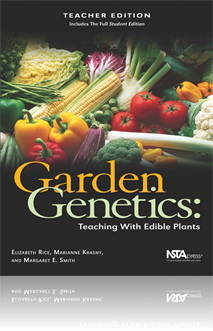All Resources
Book Chapter
Bitterness and Non-Bitterness in Cucumbers: A Story of Mutation (Teacher Edition)
In this chapter, students explore the history of the bitter gene in cucumbers, which was found in a genebank and traded internationally between cucumb...
Book Chapter
Survival Strategies (Teacher Edition)
This chapter focuses on ecological principles of plant defenses and insect adaptations to these defenses. Insects either are generalists, often deterr...
Book Chapter
Domestication: Evolving Toward Home (Teacher Edition)
This chapter explores the concept of domestication and the changes that occur in plants as they transition from wild to cultivated. Domestication is a...
Book Chapter
The Risks of Improvement: Genetic Uniformity and an Epidemic (Teacher Edition)
This chapter explores the role of genetic diversity in crops. Using hybrid corn as an example, it discusses selection—the genetic narrowing that acc...
Book Chapter
Genetic Engineering (Teacher Edition)
This chapter focuses on genetically engineered foods. Bt corn has bacterial genes that encode a protein toxic to many insects. Therefore the corn plan...
Book Chapter
Sweet Genes in Corn (Teacher Edition)
This chapter begins with consideration of sugars made by the plant during photosynthesis and the movement of those sugars within the plant by diffusio...
Book Chapter
Centers of Diversity (Teacher Edition)
This chapter discusses genetic diversity of food plants in the context of the geographic regions from which they originate. The center of origin is th...
Book Chapter
Quantitative Traits (Teacher Edition)
This chapter begins with single-gene Mendelian traits and compares them to quantitative traits where many genes are involved in determining phenotype....
Book Chapter
Bitterness and Non-Bitterness in Cucumbers: A Story of Mutation (Student Edition)
The bitterness of cucumbers is caused by a protein called cucurbitacin. The protein is found in the stems and leaves of many cucumber plants and this ...
Book Chapter
Survival Strategies (Student Edition)
Plants are part of complex ecosystems. They must defend themselves from predators. They also must compete with other plants for light, soil, nutrients...
Book Chapter
Domestication: Evolving Toward Home (Student Edition)
Domestication is literally the process of bringing an organism—animal or plant—into the home. It's easy to see the evolution from wild wolf to doc...
Book Chapter
The Risks of Improvement: Genetic Uniformity and an Epidemic (Student Edition)
In 1970, an epidemic swept through corn crops in the United States. The farmers alleged that the seed companies had behaved irresponsibility in releas...
Book Chapter
Genetic Engineering (Student Edition)
Genetically engineered crops cross boundaries that traditional crops do not and pose new and challenging regulatory issues. In the United States, a nu...
Book Chapter
Sweet Genes in Corn (Student Edition)
One of the joys of summer is sweet, fresh, crisp corn on the cob. Most corn is starchy and usually does not taste sweet. Why isn't corn on the cob sta...
Book Chapter
Centers of Diversity (Student Edition)
What country do you think is the origin of the tomato? In this chapter, tables and graphs are used to understand the relationship between food plants ...


